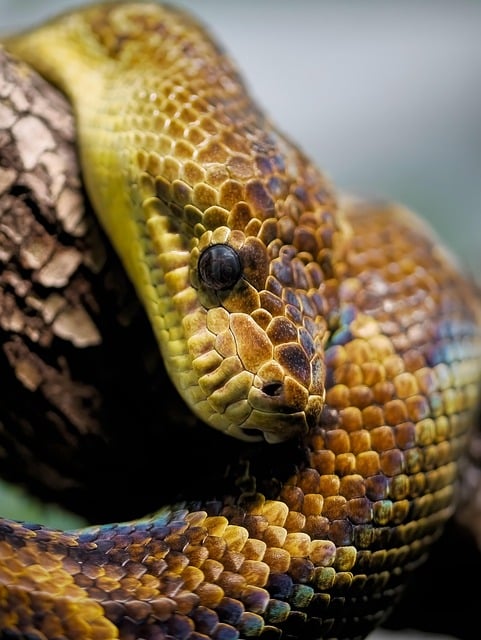Three species of tree boa are common throughout many areas of Costa Rica: garden, annulated and black-tailed. As their name indicates, all three types of tree boa are characterized by their arboreal existence.
They are very efficient constrictors, preying on lizards and small mammals while hunting in the trees at night. They also breed and give birth to their live young in their arboreal habitats. Tree boas also have in common a highly aggressive nature. They will not hesitate to inflict a painful and deep bite wound with their long teeth.
 None of them, however, is venomous, so the bites will normally heal with a little care and some topical antiseptic. All three species are best observed at night by shining a light into the trees and bushes and looking for eye shine.
None of them, however, is venomous, so the bites will normally heal with a little care and some topical antiseptic. All three species are best observed at night by shining a light into the trees and bushes and looking for eye shine.
On a warm, still night in Costa Rica, the forest looks asleep—until you sweep a torch along the canopy and a pair of amber pinpricks answer back. That eyeshine belongs to a tree boa, a hunter that prefers the night shift, coiled like a question mark along a branch and waiting for something careless to pass within striking range. These snakes are built for the treetops: prehensile tails for balance, heat-sensing pits to read the forest like thermal Braille, and a patience that would impress a heron.
Costa Rica is prime territory for two true tree-boa natives. On the Caribbean side, the Annulated Tree Boa (Corallus annulatus) ranges through lowland wet forests, often higher than you think—one reason sightings are rare unless you know to look for that tell-tale glow. It’s usually patterned with dark rings or a netted reticulation over red-brown or grey, and it’s strictly non-venomous, relying on a swift lunge and a rib-coiling squeeze to subdue lizards, birds, and small mammals. reptile-database.reptarium.cz+1
Farther south and along parts of the Pacific, the Central American or Black-tailed Tree Boa (Corallus ruschenbergerii) takes over. Heavier-bodied and often bronze with a glossy, dark tail, it can be one of the largest in its genus, with adults reaching around two metres. Like its annulated cousin, it’s nocturnal, arboreal, and happiest ambushing prey from a branch over a forest trail, mangrove edge, or stream corridor. en.wikipedia.org
You’ll sometimes hear the phrase “garden tree boa.” Strictly speaking, that common name refers to the Amazon (or garden) tree boa, a South American species. In Costa Rica, people sometimes use “garden” generically, but the resident snakes you’re likely to meet are the annulated and the black-tailed/central American species. If you’re swapping stories with locals or guides, it’s a harmless bit of naming drift—just know the science points to those two as the regulars here. inaturalist.org+2en.wikipedia.org+2
Up close (not that you should crowd them), tree boas have a serious look: broader, blockier heads than typical rat snakes, long recurved teeth for a secure grip, and a temperament best described as “no nonsense.” They won’t chase you—but if you provoke one, it will defend itself with a fast, deep bite. The good news is that neither of Costa Rica’s tree boas is venomous; a bite is painful, not poisonous, and normally heals with routine care. What they really want is to be left alone to hunt, court, and—uniquely among many snakes—give birth to live young, which appear as perfectly formed miniatures ready to climb from day one. en.wikipedia.org+1
For wildlife watchers, timing and technique matter more than luck. Go slow after dark, move your light in short, steady arcs, and pause whenever a “dewdrop” glints back at you—many first-time spotters walk past boas because they aim beams along the path instead of up into the branches and vine tangles. Scan edges: cacao groves, riparian strips, secondary forest margins. And mind the etiquette that keeps herps—and herpers—safe: no handling, no flash-blasting at close range, and no crowding animals off their perches.
How big do they get? Most adult tree boas you’ll see are in the five-to-six-foot range, with the black-tailed generally the longer and heavier of the pair. That length, combined with a prehensile tail, lets them drape across narrow boughs like living bridges, angled into an “S” just waiting to uncork. Even when perfectly still, they’re anything but relaxed: the head tracks, the pupils pin or widen, the body shifts a scale or two at a time. A boa that seems statue-calm is simply choosing not to move yet. en.wikipedia.org
Spend a few nights in good habitat and you begin to read the forest for boas the way surfers read a swell—by its tells. Cicadas ramp down. Bats stitch the airspace above a stream. A leaf rattles without wind. Then there’s that soft, unmistakable curve on a branch that wasn’t there a moment ago. The rainforest is generous with its stars: toucans, sloths, cats, and frogs. But once you’ve caught the eyes of a tree boa at midnight, you understand why many guides quietly rank them among the country’s finest sightings.
Quick IDs (keep it simple):
-
Annulated Tree Boa (Corallus annulatus): Caribbean versant; dark rings or netted pattern over red-brown or grey; uncommon and high in the canopy. reptile-database.reptarium.cz+1
-
Black-tailed/Central American Tree Boa (Corallus ruschenbergerii): Pacific south and southern CR; bronze-to-grey body with a shiny black tail; larger, heavier build. en.wikipedia.org
-
Status & safety: Non-venomous constrictors; defensive bites possible—observe, don’t handle.
The garden tree boa occurs in many different color phases and patterns, from grays and browns to vibrant yellows, reds and oranges.
The annulated tree boa occurs in two common color phases of red or gray, with varying intensities of each.
The black-tailed tree boa is normally only bronze and black, with a distinct pattern and a shiny black tail.
 Adult tree boas average five to six feet in length, with the black-tailed tree boa being the longest and heaviest. The annulated tree boa can be distinguished from the garden tree boa by its heavier body and chunkier, broader head.
Adult tree boas average five to six feet in length, with the black-tailed tree boa being the longest and heaviest. The annulated tree boa can be distinguished from the garden tree boa by its heavier body and chunkier, broader head.






